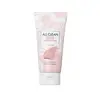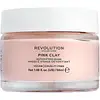What's inside
What's inside
 Key Ingredients
Key Ingredients

 Benefits
Benefits

 Concerns
Concerns

 Ingredients Side-by-side
Ingredients Side-by-side

Water
Skin ConditioningGlycerin
HumectantCalamine
AbsorbentZinc Oxide
Cosmetic ColorantKaolin 6%
AbrasiveBentonite 4%
AbsorbentDipropylene Glycol
HumectantGlyceryl Stearate
EmollientPalmitic Acid
EmollientStearic Acid
Cleansing1,2-Hexanediol
Skin ConditioningAmyris Balsamifera Bark Oil
MaskingLavandula Angustifolia Oil
MaskingPelargonium Graveolens Flower Oil
MaskingEucalyptus Globulus Leaf Oil
PerfumingLitsea Cubeba Fruit Oil
MaskingMentha Arvensis Leaf Oil
MaskingMelaleuca Alternifolia Leaf Oil
AntioxidantJuniperus Mexicana Oil
MaskingCitrus Aurantium Bergamia Fruit Oil
MaskingVolcanic Ash
AbrasiveBoswellia Carterii Oil
MaskingMyristica Fragrans Kernel Oil
MaskingCitrus Aurantium Dulcis Peel Oil
MaskingHamamelis Virginiana Water
AstringentCamellia Japonica Flower Extract
EmollientTagetes Minuta Flower Oil
MaskingCitrus Paradisi Peel Oil
MaskingEpilobium Fleischeri Extract
Skin ConditioningMoringa Oleifera Seed Extract
Skin ConditioningRosa Multiflora Fruit Extract
MaskingPortulaca Oleracea Extract
Skin ConditioningGossypium Herbaceum Seed Extract
Skin ConditioningCaprylic/Capric Triglyceride
MaskingTromethamine
BufferingCaprylyl Glycol
EmollientCellulose Gum
Emulsion StabilisingPanthenol
Skin ConditioningEthylhexylglycerin
Skin ConditioningSodium Phytate
Myristic Acid
CleansingAllantoin
Skin ConditioningArachidic Acid
CleansingLauric Acid
CleansingOleic Acid
EmollientButylene Glycol
HumectantZinc PCA
HumectantMaltodextrin
AbsorbentTocopherol
AntioxidantCitric Acid
BufferingXanthan Gum
EmulsifyingPotassium Sorbate
PreservativeLimonene
PerfumingParfum
MaskingCI 77492
Cosmetic ColorantCI 77491
Cosmetic ColorantWater, Glycerin, Calamine, Zinc Oxide, Kaolin 6%, Bentonite 4%, Dipropylene Glycol, Glyceryl Stearate, Palmitic Acid, Stearic Acid, 1,2-Hexanediol, Amyris Balsamifera Bark Oil, Lavandula Angustifolia Oil, Pelargonium Graveolens Flower Oil, Eucalyptus Globulus Leaf Oil, Litsea Cubeba Fruit Oil, Mentha Arvensis Leaf Oil, Melaleuca Alternifolia Leaf Oil, Juniperus Mexicana Oil, Citrus Aurantium Bergamia Fruit Oil, Volcanic Ash, Boswellia Carterii Oil, Myristica Fragrans Kernel Oil, Citrus Aurantium Dulcis Peel Oil, Hamamelis Virginiana Water, Camellia Japonica Flower Extract, Tagetes Minuta Flower Oil, Citrus Paradisi Peel Oil, Epilobium Fleischeri Extract, Moringa Oleifera Seed Extract, Rosa Multiflora Fruit Extract, Portulaca Oleracea Extract, Gossypium Herbaceum Seed Extract, Caprylic/Capric Triglyceride, Tromethamine, Caprylyl Glycol, Cellulose Gum, Panthenol, Ethylhexylglycerin, Sodium Phytate, Myristic Acid, Allantoin, Arachidic Acid, Lauric Acid, Oleic Acid, Butylene Glycol, Zinc PCA, Maltodextrin, Tocopherol, Citric Acid, Xanthan Gum, Potassium Sorbate, Limonene, Parfum, CI 77492, CI 77491
Water
Skin ConditioningKaolin
AbrasiveMagnesium Aluminum Silicate
AbsorbentBentonite
AbsorbentGlycerin
HumectantXanthan Gum
EmulsifyingHamamelis Virginiana Water
AstringentPhenoxyethanol
PreservativeParfum
MaskingCitric Acid
Buffering1-Methylhydantoin-2-Imide
Skin ConditioningEthylhexylglycerin
Skin ConditioningMontmorillonite
AbsorbentIllite
Abrasive2-Bromo-2-Nitropropane-1,3-Diol
PreservativeFucus Vesiculosus Extract
EmollientAloe Barbadensis Leaf Juice Powder
Skin ConditioningPotassium Sorbate
PreservativeSodium Benzoate
MaskingCI 77491
Cosmetic ColorantWater, Kaolin, Magnesium Aluminum Silicate, Bentonite, Glycerin, Xanthan Gum, Hamamelis Virginiana Water, Phenoxyethanol, Parfum, Citric Acid, 1-Methylhydantoin-2-Imide, Ethylhexylglycerin, Montmorillonite, Illite, 2-Bromo-2-Nitropropane-1,3-Diol, Fucus Vesiculosus Extract, Aloe Barbadensis Leaf Juice Powder, Potassium Sorbate, Sodium Benzoate, CI 77491
Ingredients Explained
These ingredients are found in both products.
Ingredients higher up in an ingredient list are typically present in a larger amount.
Bentonite is an aluminium phyllosilicate clay with great absorbent properties. The name 'bentonite' comes from the area where the largest source is found: Fort Benton, Wyoming.
As a clay, bentonite is often used to absorb excess oil and provide exfoliation. It has also been shown to have some antibacterial and anti-inflammatory properties. Studies show bentonite was effective at calming dermatitis from poison ivy and in diaper dermatitis of infants. Bentonite has also been shown to act as a barrier against toxic compounds on your skin.
Sunscreens containing bentonite display higher water resistance and stay on the skin for much longer. The sunscreens containing bentonite also show higher potency and UV light absorbtion.
Bentonite is naturally created from volcanic ash and several natural weathering/hydrothermal processes.
A common usage of bentonite is removing excess protein from white wines. Bentonite contains a property of being able to absorb large amounts of protein from aqueous solutions.
Phyllosilicate clay has a structure formed by sheets.
Learn more about BentoniteCi 77491 is also hydrated iron III oxide. It's sole purpose is to give a red/pink hue to products.
Iron III oxides are classified as inorganic chemicals for coloring.
Synthetically created Ci 77491 is considered safer than those naturally found. This is because the synthetically created version may contain less impurities. Iron oxides are generally non-toxic and non-allergenic.
Learn more about CI 77491Citric Acid is an alpha hydroxy acid (AHA) naturally found in citrus fruits like oranges, lemons, and limes.
Like other AHAs, citric acid can exfoliate skin by breaking down the bonds that hold dead skin cells together. This helps reveal smoother and brighter skin underneath.
However, this exfoliating effect only happens at high concentrations (20%) which can be hard to find in cosmetic products.
Due to this, citric acid is usually included in small amounts as a pH adjuster. This helps keep products slightly more acidic and compatible with skin's natural pH.
In skincare formulas, citric acid can:
While it can provide some skin benefits, research shows lactic acid and glycolic acid are generally more effective and less irritating exfoliants.
Most citric acid used in skincare today is made by fermenting sugars (usually from molasses). This synthetic version is identical to the natural citrus form but easier to stabilize and use in formulations.
Read more about some other popular AHA's here:
Learn more about Citric AcidEthylhexylglycerin (we can't pronounce this either) is commonly used as a preservative and skin softener. It is derived from glyceryl.
You might see Ethylhexylglycerin often paired with other preservatives such as phenoxyethanol. Ethylhexylglycerin has been found to increase the effectiveness of these other preservatives.
Glycerin is already naturally found in your skin. It helps moisturize and protect your skin.
A study from 2016 found glycerin to be more effective as a humectant than AHAs and hyaluronic acid.
As a humectant, it helps the skin stay hydrated by pulling moisture to your skin. The low molecular weight of glycerin allows it to pull moisture into the deeper layers of your skin.
Hydrated skin improves your skin barrier; Your skin barrier helps protect against irritants and bacteria.
Glycerin has also been found to have antimicrobial and antiviral properties. Due to these properties, glycerin is often used in wound and burn treatments.
In cosmetics, glycerin is usually derived from plants such as soybean or palm. However, it can also be sourced from animals, such as tallow or animal fat.
This ingredient is organic, colorless, odorless, and non-toxic.
Glycerin is the name for this ingredient in American English. British English uses Glycerol/Glycerine.
Learn more about GlycerinHamamelis Virginiana Water is made by distilling parts of the witch hazel plant. You can also call this ingredient "witch hazel water".
The name 'Hamamelis Virginiana Water' refers to the distillation product used in cosmetics. On the other hand, 'Witch Hazel' refers to the active drug ingredient.
Unless it is specified to be non-alcohol, many types of witch hazel ingredients are distilled in denatured alcohol.
Witch Hazel water is an astringent, anti-inflammatory antioxidant, and antibacterial ingredient.
It contains tannins. Tannins have a drying effect when used on skin by constricting proteins. The constriction also minimizes the appearance of pores.
Both the tannins and fragrance found in witch hazel may be skin-sensitizing.
Witch hazel water gets anti-inflammatory and antibacterial properties from its catechin and gallic acid content.
Indigenous groups have used witch hazel to help treat inflammation in North America for centuries.
Learn more about Hamamelis Virginiana WaterKaolin is a clay. It is used for oil control and to help minimize pores. Like other clays, kaolin has the ability to absorb excess sebum or oil. This can help clean out pores and mattify the skin.
Some types of kaolin may have exfoliating properties. When water is added to kaolin, it becomes a paste with small abrasive particles.
Most kaolin is a white color, but may be pink/orange/red depending on where it comes from.
The name 'kaolin' comes from a Chinese village named 'Gaoling'. Kaolin clay comes from rocks rich in kaolinite. Kaolinite, the mineral, has a silicate layered structure. Kaolinite is formed from chemical weathering of aluminum siilicate minerals.
Besides skincare, kaolin is commonly used to make glossy paper, in ceramics, toothpaste, and as medicine to soothe stomach issues.
Learn more about KaolinParfum is a catch-all term for an ingredient or more that is used to give a scent to products.
Also called "fragrance", this ingredient can be a blend of hundreds of chemicals or plant oils. This means every product with "fragrance" or "parfum" in the ingredients list is a different mixture.
For instance, Habanolide is a proprietary trade name for a specific aroma chemical. When used as a fragrance ingredient in cosmetics, most aroma chemicals fall under the broad labeling category of “FRAGRANCE” or “PARFUM” according to EU and US regulations.
The term 'parfum' or 'fragrance' is not regulated in many countries. In many cases, it is up to the brand to define this term.
For instance, many brands choose to label themselves as "fragrance-free" because they are not using synthetic fragrances. However, their products may still contain ingredients such as essential oils that are considered a fragrance by INCI standards.
One example is Calendula flower extract. Calendula is an essential oil that still imparts a scent or 'fragrance'.
Depending on the blend, the ingredients in the mixture can cause allergies and sensitivities on the skin. Some ingredients that are known EU allergens include linalool and citronellol.
Parfum can also be used to mask or cover an unpleasant scent.
The bottom line is: not all fragrances/parfum/ingredients are created equally. If you are worried about fragrances, we recommend taking a closer look at an ingredient. And of course, we always recommend speaking with a professional.
Learn more about ParfumPotassium Sorbate is a preservative used to prevent yeast and mold in products. It is commonly found in both cosmetic and food products.
This ingredient comes from potassium salt derived from sorbic acid. Sorbic acid is a natural antibiotic and effective against fungus.
Both potassium sorbate and sorbic acid can be found in baked goods, cheeses, dried meats, dried fruit, ice cream, pickles, wine, yogurt, and more.
You'll often find this ingredient used with other preservatives.
Learn more about Potassium SorbateWater. It's the most common cosmetic ingredient of all. You'll usually see it at the top of ingredient lists, meaning that it makes up the largest part of the product.
So why is it so popular? Water most often acts as a solvent - this means that it helps dissolve other ingredients into the formulation.
You'll also recognize water as that liquid we all need to stay alive. If you see this, drink a glass of water. Stay hydrated!
Learn more about WaterXanthan gum is used as a stabilizer and thickener within cosmetic products. It helps give products a sticky, thick feeling - preventing them from being too runny.
On the technical side of things, xanthan gum is a polysaccharide - a combination consisting of multiple sugar molecules bonded together.
Xanthan gum is a pretty common and great ingredient. It is a natural, non-toxic, non-irritating ingredient that is also commonly used in food products.
Learn more about Xanthan Gum